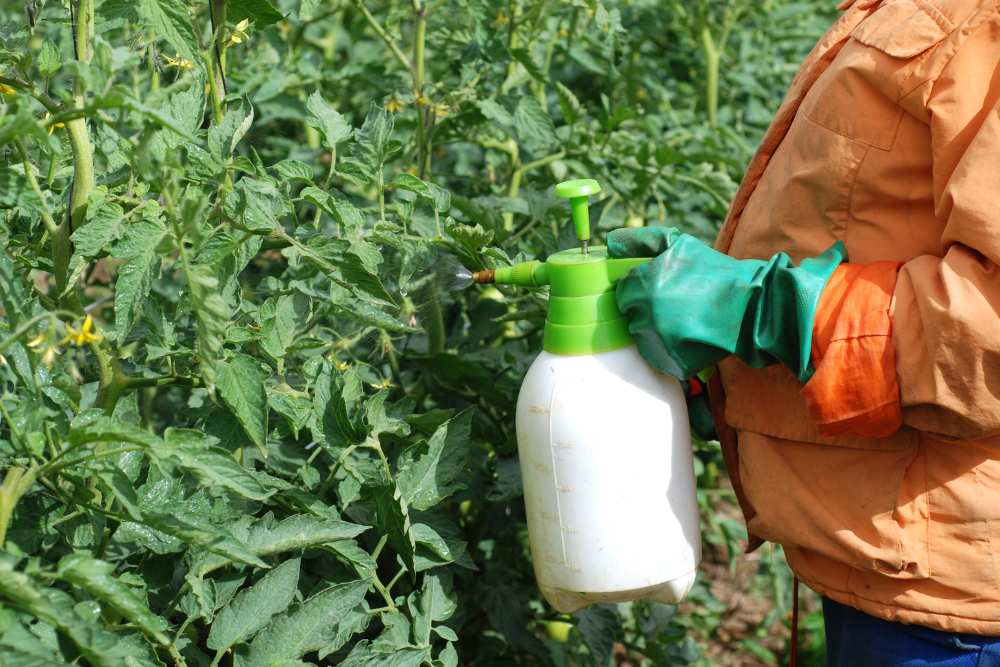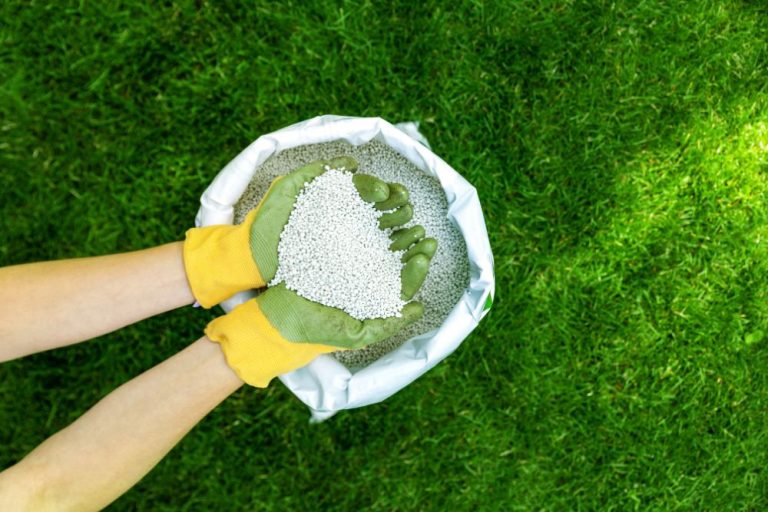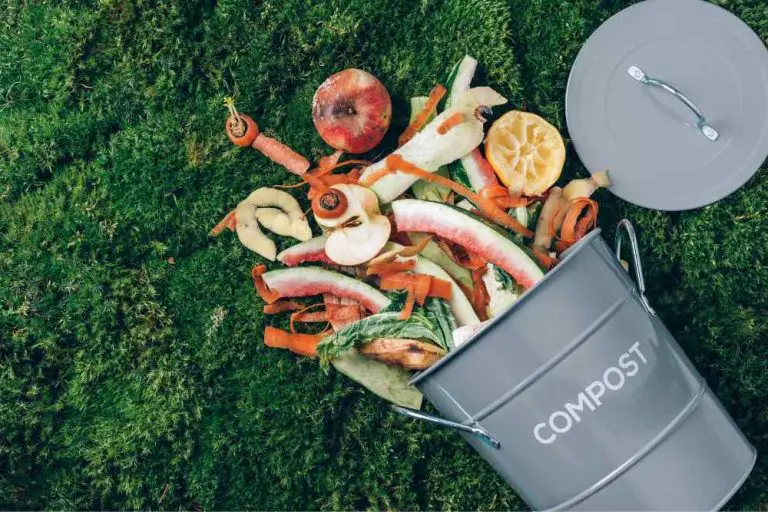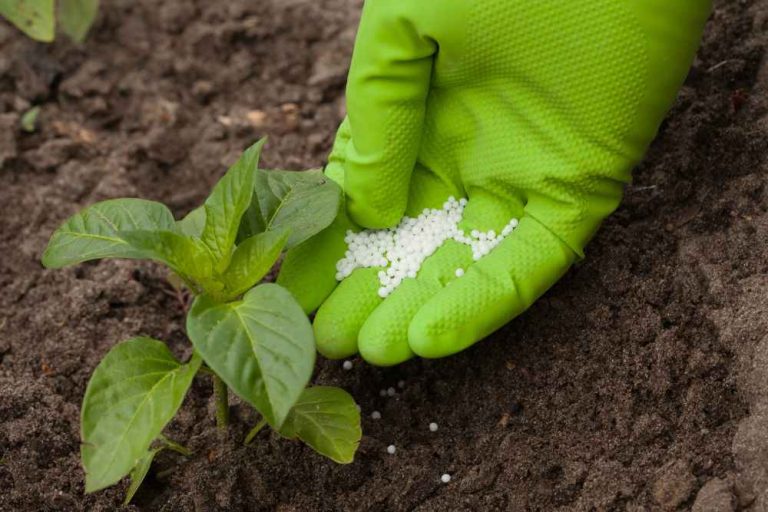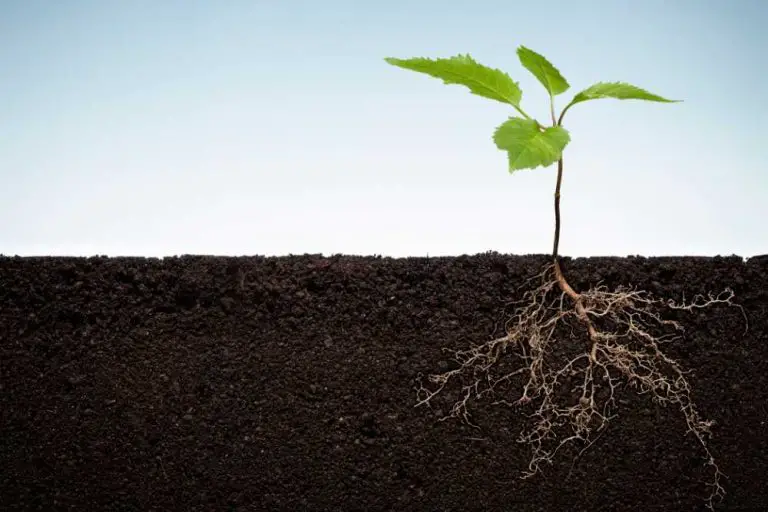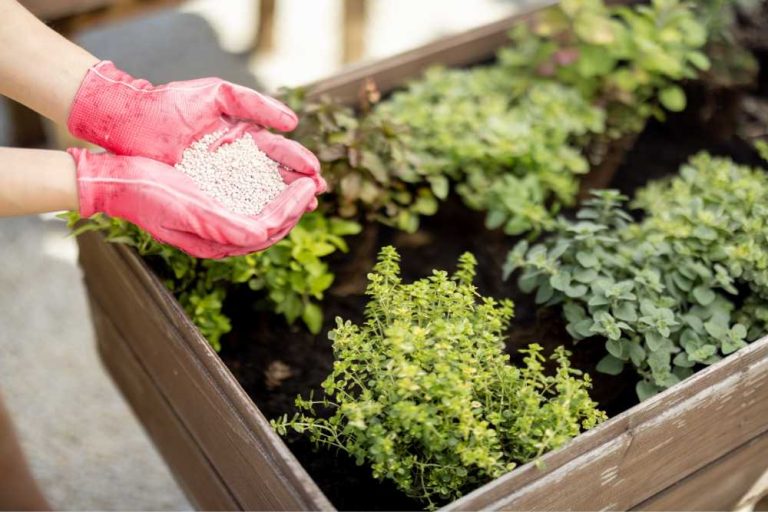10 Best Fertilizer for Tomatoes and Peppers: Boost Your Harvest
Tomatoes, like many annuals, are heavy feeders that thrive when given the nutrition to grow throughout the season. Fertilizers, whether chemical or organic, can in offering the extra nutrients that tomatoes require to grow swiftly.
But what really constitutes a decent tomato fertilizer? When should you fertilize tomato plants? And also It’s normal to have doubts about your fertilizer practices when growing peppers. Do I fertilize too frequently? Isn’t it enough? We’ve all been there. In this article, we’ll go over some of the best fertilizer for tomatoes and pepper.
Practical Tips and Common Mistakes: Fertilizing Tomatoes and Peppers
Fertilizing your tomatoes and peppers correctly can significantly impact their health and yield. Here are practical tips and common mistakes to keep in mind for optimal results.
Practical Tips
Common Mistakes
Environmental Impact Information
When discussing the fertilization of tomatoes and peppers, it’s crucial to consider the environmental implications of our practices. The way we fertilize can have far-reaching effects on soil health, water quality, and biodiversity. Here’s a comprehensive look at these impacts and how to minimize negative effects.
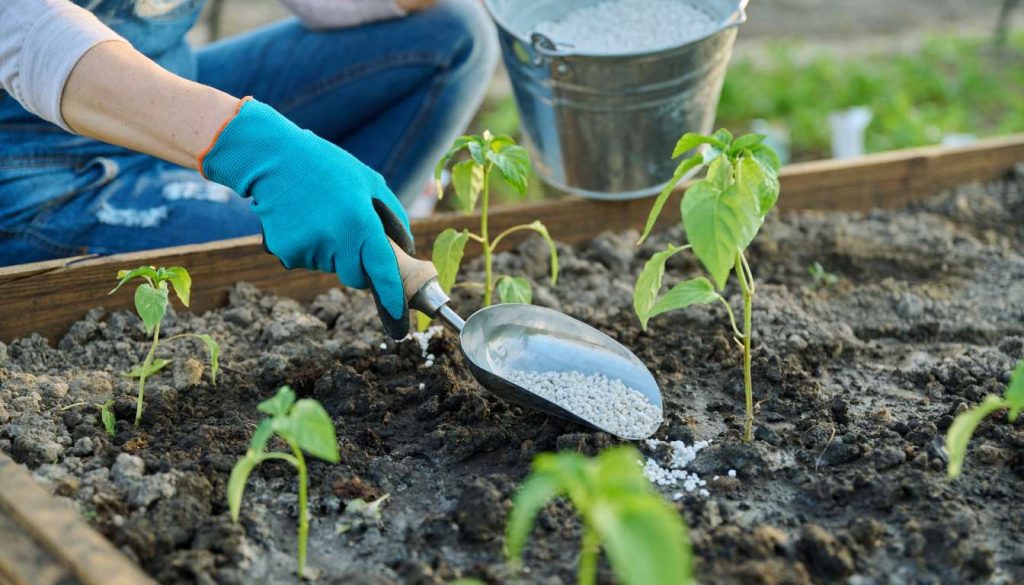
Nutrient Runoff and Water Pollution
One of the primary concerns with fertilizer use is nutrient runoff. Excess nitrogen and phosphorus from fertilizers can leach into waterways, leading to eutrophication – a process that causes harmful algal blooms depletes oxygen in water, and harms aquatic life.
Preventive Measures:
- Use fertilizers judiciously, applying them according to plant needs and soil tests.
- Employ slow-release fertilizers that are less likely to leach away.
- Incorporate buffer zones with plants or grasses around garden areas to absorb runoff.
Soil Health Degradation
The overuse of chemical fertilizers can disrupt the natural balance of soil, harming its structure and the microorganisms vital for a healthy ecosystem. This degradation can lead to reduced soil fertility and increased erosion.
Sustainable Practices:
- Integrate organic fertilizers, like compost or manure, which improve soil structure and promote microbial life.
- Practice crop rotation and intercropping to maintain soil health.
- Avoid excessive tilling, which disrupts soil structure and microbial habitats.
Greenhouse Gas Emissions
The production and use of synthetic fertilizers are significant sources of greenhouse gases, notably nitrous oxide, a potent greenhouse gas. The process of manufacturing these fertilizers is also energy-intensive, contributing to CO2 emissions.
Eco-Friendly Alternatives:
- Opt for organic or naturally derived fertilizers.
- Use composting to create a nutrient-rich soil amendment from kitchen and garden waste.
- Implement integrated pest management to reduce the need for chemical fertilizers.
Impact on Biodiversity
Heavy fertilizer use can affect biodiversity. In terrestrial ecosystems, it can lead to an overgrowth of certain plant species, which outcompete others and reduce diversity. In aquatic systems, as mentioned, eutrophication can significantly disrupt life.
Biodiversity-Friendly Techniques:
- Maintain a balance in fertilization to prevent dominance of aggressive plant species.
- Use native plants in garden designs to support local ecosystems.
- Create habitats for beneficial insects and wildlife to promote ecological balance.
Human Health Considerations
Lastly, the impact on human health cannot be overlooked. Chemicals from fertilizers can contaminate groundwater, posing risks to drinking water.
Health-Conscious Strategies:
- Follow recommended guidelines for fertilizer application to prevent leaching into groundwater.
- Consider using organic fertilizers, which are less likely to contain harmful chemicals.
- Test soil and water sources regularly for contaminants.
What is the Best Fertilizer for Peppers?
1. Miracle-Gro Water Soluble Plant Food Vegetables
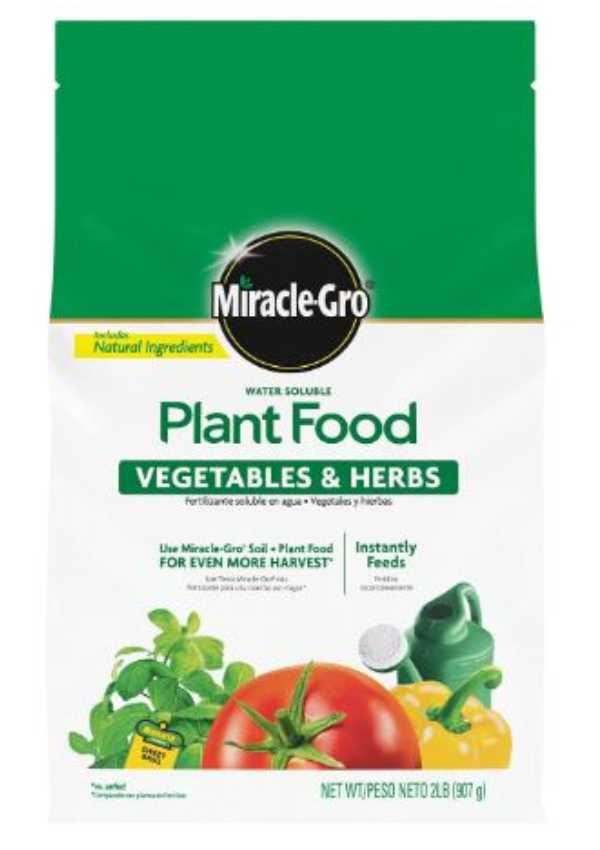
The water-soluble Miracle-Gro vegetable and herb fertilizer is available in granular form but quickly dissolves in water, making it ideal for use in a garden feeder or watering can. Its 18-18-21 composition promotes strong root development and robust plant growth while also increasing flower production.
Use 1.5 tablespoons of the granules per 1.5 liters of water to dissolve them. The 2-pound bag will fertilize up to 800 square feet of the garden when used following the instructions on the feeder when using a hose-style garden feeder. Gardeners should reapply this high-nutrient fertilizer every seven to ten days for the greatest results; it is excellent for use on both vegetables and herbs.
The formula stimulates strong root development and vigorous growth. Granules are packaged, but they dissolve readily in water. Apply every week to 10 days in a watering can or hose sprayer to boost flower production.
- For optimal results, apply almost weekly.
- It does not contain calcium
2. Tomato-tone Organic Fertilizer from Espoma
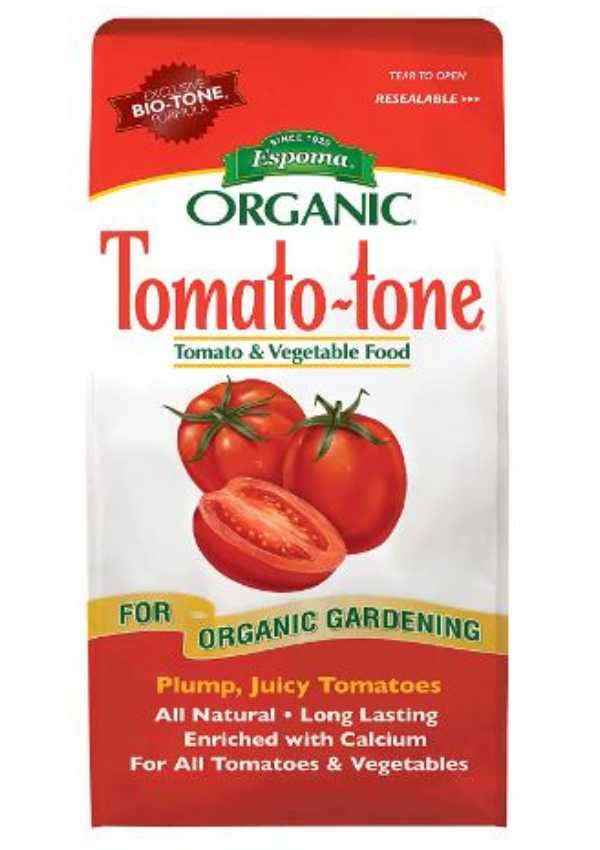
Tomato-tone Espoma Organic Fertilizer is one of the best tomato fertilizers. The organic mixture aids in the production of excellent tomatoes as well as fruiting vegetables such as peppers, squash, and melons. It can be used to nourish both young and established plants as well as to improve the soil before seeding. It’s a 3-4-6 fertilizer containing 8% calcium to keep flower ends from rotting.
It contains each and every necessary nutrient for tomato plants. Microbes that support healthy soil and offer long-lasting, slow-release plant food are present in tomato-tone. In the spring, a 4-pound package of Tomato-tone fertilizer is sufficient to prepare a 50-square-foot vegetable garden. On the other hand, it can supply food for a 10-foot row of tomato plants for three months in the summer. Furthermore, it is organic and environmentally friendly.
- More blossoms are encouraged for maximum fruit production
- It has been shown to support healthy plant growth
- It contains 8% calcium, which aids in the prevention of blossom end rot
- Long-lasting, slow-release feeding using our exclusive Bio-tone Microbes, made with only natural, organic components and free of fillers and sludges
3. Jobe’s Organics Vegetable and Tomato Fertilizer 4 lb
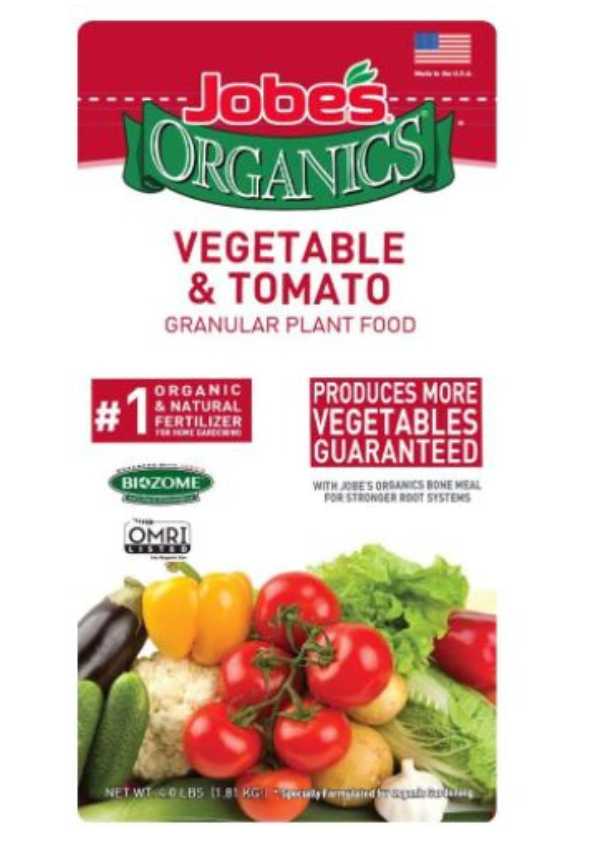
Jobe’s Organics Vegetable and Tomato Fertilizer 4 lb is formulated specifically for tomatoes. However, it benefits all of your edible plants, including cabbages, squash, garlic, cucumbers, and others. It’s a 2-5-3 calcium fertilizer that has been OMRI-certified for organic farming.
This fertilizer contains the exclusive Jobe’s Biozome blend of beneficial bacteria, fungi, and other microorganisms. These components help your soil become healthier and aid in the drought and disease resistance of your tomato plants. It’s a fast-acting fertilizer that can be used for soil preparation as well as feeding new and existing plants. Jobe’s Organics are eco-friendly, regenerative, child- and animal-friendly, and great for your vegetable garden.
- Jobe’s Biozome helps to enhance soil conditions
- Bag with an easy pour
- Organic granular fertilizer
4. Jobe’s Organics Vegetable & Tomato Fertilizer Spikes
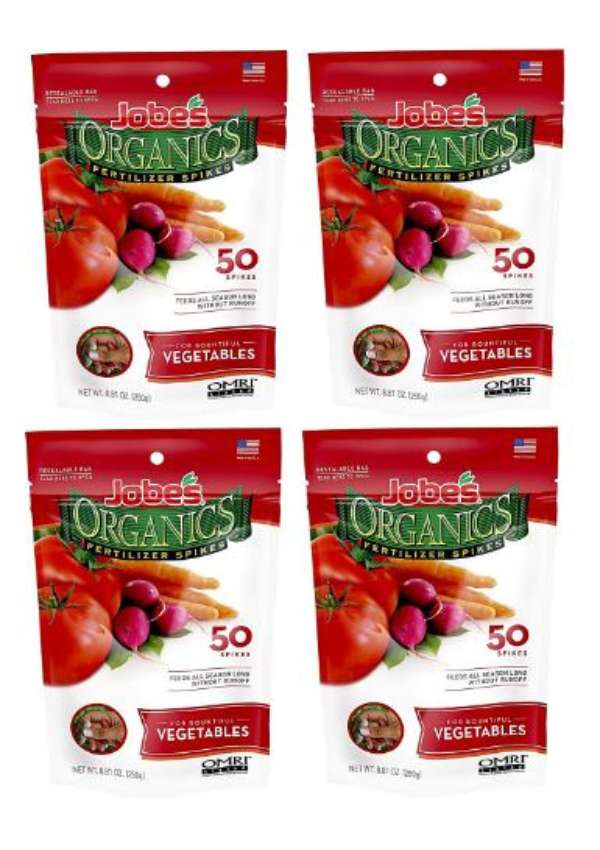
Jobe’s Organics Vegetable & Tomato Fertilizer, perhaps the most basic of fertilizers, comes with 50 fertilizing spikes. Gardeners place the spikes around the plants in the soil. The spikes gradually disappear, supplying a steady flow of slowly released nutrients for up to six weeks until new spikes are required. This 2-7-4 combination promotes vigorous blossoming and the production of huge, tasty tomatoes and peppers.
Additionally, it is an organic fertilizer that contains sulfate of potash, feather meal, and bone meal, so gardeners won’t ever need to be concerned about the nutritional worth of their produce. Use these spikes every eight weeks following the initial planting of new plants in the garden (or container) for optimal results. Insert four spikes for an 8-inch spread plant and eight spikes for a 12-inch spread plant, then water after insertion.
- The formula for slow release disintegrates gradually to prevent surges
- Feeds for a period of up to 6 weeks
- Designed to promote blooming and huge fruits
- Ingredients that are organically certified
- Spikes need to be buried deeper since dogs might be drawn to them
5. Dr. Earth Organic Tomato, Vegetable & Herb Fertilizer
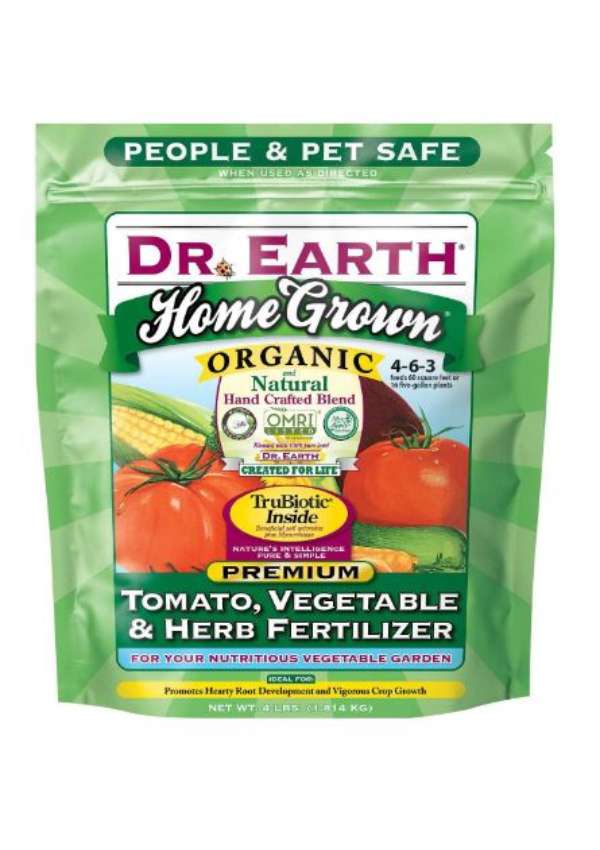
The Dr. Earth Organic 4-6-3 Tomato, Vegetable & Herb Fertilizer is a fertilizer that encourages healthy soil for the greatest growth of tomatoes, herbs, and vegetables. Dr. Earth Organic Vegetable Fertilizer is a formulation full of organic components like fishbone meal, bone meal, alfalfa meal, and kelp flour to provide peppers and other veggies with the natural nutrients they require—without chemicals.
This fertilizer mix is OMRI-, OIM-, CCOF-, NOP-, and Non-GMO-Project-certified. It can be applied while transplanting, to feed mature plants, or to nourish seedlings. This formula will last for several months.
Dr. Earth has ecto and endo mycorrhizae and beneficial probiotic bacteria to sustainably improve the soil. It is also safe for children and pets as well. Dr. Earth Organic Tomato Fertilizer is produced in an eco-friendly method in the United States.
Additionally, the product has 7.5% calcium to assist enrich the soil and encourage healthy cell growth, giving plants a better chance to withstand drought and other calcium-related problems.
Add 1.3 cups of Dr. Earth granules to every 10 square feet of soil before planting peppers or tomatoes, or 0.5 cups for every 0.5 cubic feet of growing media for vegetables grown in containers. Put the grains a few inches deep into the soil.
- Granular, organic fertilizer for foods such as peppers
- Includes fishbone meal and other natural components; no chemicals are used
- There has been an addition of calcium
- During the season, it is only necessary to apply it every two months
- When applying, granules must be worked into the soil. The smell of the substances may draw dogs to containers
6. TeaDrops Organic Liquid Plant Food
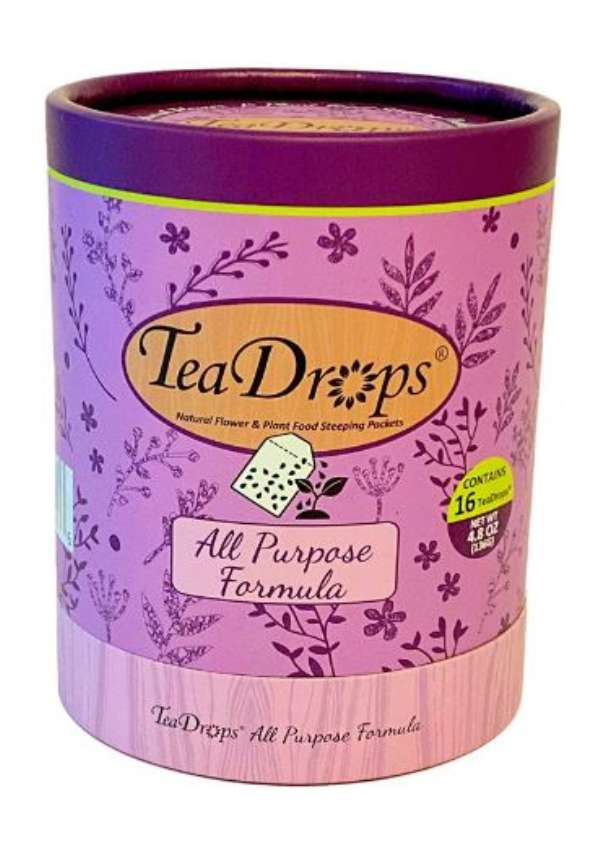
TeaDrops Organic Liquid Plant Food is available in a special form that makes it easy to use without creating a mess or needing to measure. Simply soak the fertilizer packets in water to make a nourishing compost tea. Your tomato and pepper plants will be fed and watered by the tea. Utilizing natural plant fungi, bacteria, and humic acids, this low NPK product improves plant health. These chemicals, combined with naturally existing plant growth hormones, enrich the soil naturally.
TeaDrops can be used as a root drench, seedling mist, foliar spray, or basic plant nourishment. They may also be used to moisten the roots of seedlings. The best feature is that it never burns your plants. It is completely organic, kid- and pet-friendly, and American-made using sustainable practices. Toss the packages into your composter after use. To add organic nutrients to your garden soil, you might also open them and sprinkle the contents over them.
- The highest-quality and most convenient liquid organic fertilizer you’ll ever need for tomatoes, peppers, and eggplant
- Enjoy outstanding natural growth!
- Eco-friendly,
- Child-friendly, and pet friendly
- 100% organic & made in the USA
7. Miracle-Gro Water Soluble Plant Food Vegetables
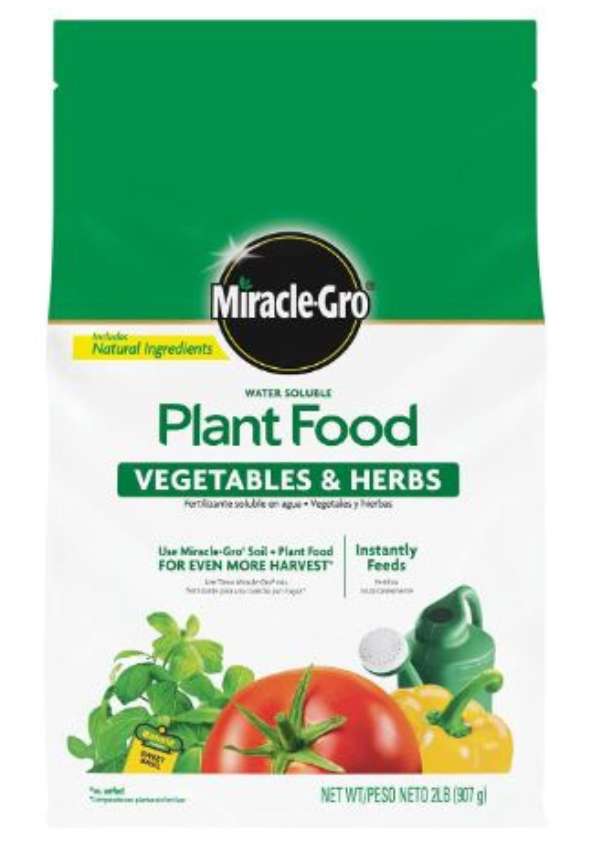
Miracle-Gro vegetable and herb fertilizer are water soluble granular, but it dissolves fast in the water, making them ideal for use in a watering can or hose-type garden feeder. Its 18-18-21 formulation promotes strong root development and vigorous plant growth, as well as increased flower production.
Use 1.5 tablespoons of the granules per 1.5 liters of water to dissolve them. Follow the instructions on the feeder when using a hose-style garden feeder; a 2-pound bag of fertilizer will cover up to 800 square feet of the garden. Gardeners should reapply this high-nutrient fertilizer every seven to ten days for the greatest results; it is excellent for use on both vegetables and herbs.
- They are packaged as granules, but they dissolve easily in water
- The formula promotes healthy root growth and development
- Apply in a watering can or hose sprayer every week to ten days
- For optimal effects, the application should be made virtually every week
- There is no calcium in this product
8. Purely Organic Products Tomato &Vegetable Plant Food
Purely Organic Products Tomato & Vegetable Plant Food will feed peppers, maize, and other vegetables for up to eight weeks before requiring reapplication. This organic product contains only natural nutrients including feather meal, blood meal, and soybean meal in a balanced 8-8-8 composition to help build healthy roots and yield large, flavorful veggies.
When transplanting new plants into a garden plot, use.66 cups of Purely Organic Products fertilizer for every 25 square feet of soil. Use 1.5 teaspoons per 12-inch diameter pot for containers.
Spread the granules uniformly throughout the soil and work them into a depth of 2 to 3 inches. Apply 1.25 cups per 49 feet of soil in established vegetable garden beds and 1.5 teaspoons per 12-inch pot in container-grown types. The fertilizer weighs 2.25 pounds in the package.
- A well-balanced formula aids in the establishment of healthy roots and the production of huge fruit
- Works during the transplant process and for up to 8 weeks
- When applying, it’s necessary to work the granules into the soil and moisten them
9. Organic Tomato & Vegetable Plant Food Fertilize
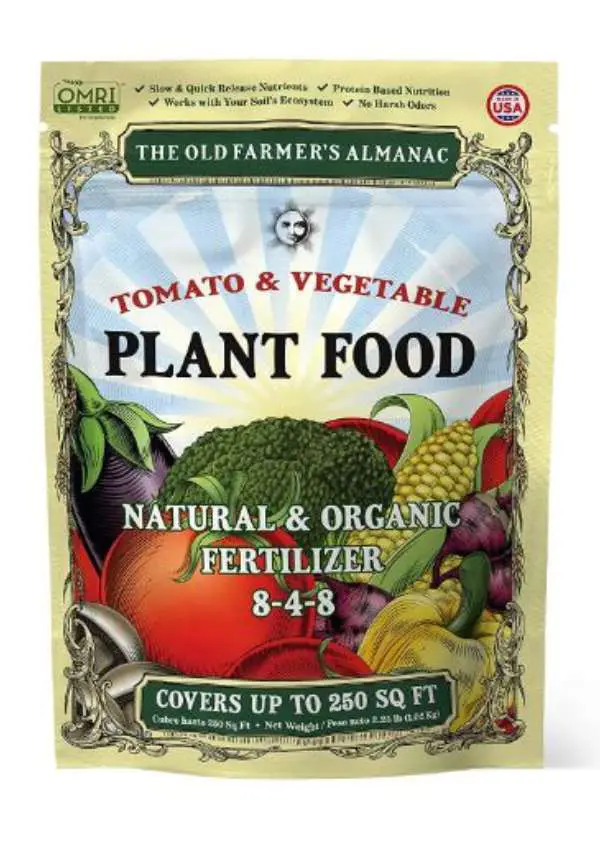
The Old Farmer’s Almanac may be able to assist you in getting your new vegetable plants started. Growers can use organic vegetable fertilizer before and after transplanting to promote a healthy environment for pepper and tomato plants. This 8-4-8 composition will promote healthy root growth and increase the output of vegetables, flowers, and leaves.
When transferring young vegetable plants to the garden or containers, it comes in granular form for dusting on the soil at a rate of 1.5 tablespoons per square foot of soil. Repeat spraying every six to eight weeks for the healthiest plants and the largest crop. Soybean meal, feather meal, bone meal, blood meal, and potash sulfate are all ingredients in this organic fertilizer. It weighs 2.25 pounds and has a 250-square-foot treatment area.
- When transplanting peppers and other vegetables, this is an excellent beginning fertilizer
- Increases leaf growth and encourages strong root development
- It is only essential to reapply every 6 to 8 weeks. Natural substances that have been verified
- When feeding, the ground should be worked with the granules
- This could result in mold growth in the soil
10. Botanicare HGC732110 Cal-Mag Plus, A Calcium
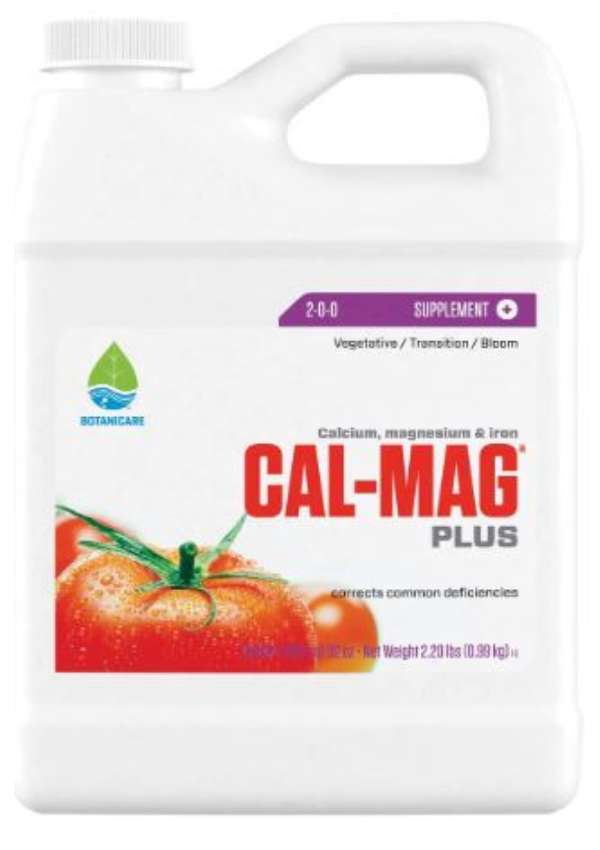
Botanicare’s HGC732110 Cal-Mag Plus Plant Supplement is a foliar spray (meaning the product is applied directly to the leaves of a plant) as well as a soil fertilizer. For direct application to the leaves of pepper plants and other vegetable plants, the formula can be diluted at a rate of 1 teaspoon of Cal-Mag per gallon of water and placed in a sprayer.
This 2-0-0 formulation contains no phosphorus or phosphate, but it does include 3.2 percent calcium, 1.2 percent magnesium, and 0.1 percent iron, making it useful for minimizing blossom-end rot, which can occasionally plague tomatoes and peppers. By combining Cal-Mag Plus in the same proportion, it is also acceptable for hydroponically grown vegetables.
A specific mixture of additional trace minerals is included in the fertilizer, which is intended to create a lot of flowers and huge vegetable specimens. One quart-sized container of the product is standard; however, various sizes might be offered.
- Fertilizer for the soil or a concentrated foliar spray contains minerals including calcium, magnesium, and trace elements
- It prevents blossom-end rot and promotes profuse fruiting
- Before using the liquid concentrate, it must be diluted in water
- Supplement to a balanced fertilizer, therefore an extra step that is still valuable
FAQ
How often should I fertilize my tomatoes and peppers?
The frequency of fertilization depends on the growth stage of the plants and the type of fertilizer used. Generally, after planting, you can fertilize every 2-4 weeks. However, it’s important to follow the instructions on your specific fertilizer and adjust based on plant response and soil tests.
Can I use the same fertilizer for both tomatoes and peppers?
Yes, tomatoes and peppers have similar nutrient requirements. A balanced fertilizer, typically one with equal parts nitrogen, phosphorus, and potassium (N-P-K), is suitable for both. However, individual needs may vary, so observe your plants and adjust accordingly.
What are the signs that my plants are over-fertilized?
Over-fertilization can lead to leaf burn, characterized by brown or yellow edges on leaves. You may also notice stunted growth or an abundance of foliage with few fruits. If you suspect over-fertilization, reduce the frequency and amount of fertilizer and water the plants well to help flush out excess nutrients.
Is it better to use organic or synthetic fertilizers?
Both have their advantages. Organic fertilizers improve soil health over time and are environmentally friendly, but they may act more slowly. Synthetic fertilizers provide immediate nutrients. The choice depends on your gardening practices, environmental concerns, and specific plant needs.
How do I know if my soil needs additional nutrients?
The best way is to conduct a soil test. This test will give you a detailed analysis of nutrient levels and pH, helping you make informed decisions about fertilization. Without a test, watch for signs like poor growth, leaf discoloration, or reduced fruiting.
Can too much fertilizer affect the taste of tomatoes and peppers?
Yes, excessive fertilizer, particularly nitrogen, can lead to rapid growth with diluted flavors in fruits. Balanced fertilization is key to achieving the best taste.
Are there any specific environmental concerns with fertilizing these plants?
The main concerns include nutrient runoff leading to water pollution, soil health degradation, and the impact of synthetic fertilizers on greenhouse gas emissions. Using fertilizers responsibly and considering organic options can help mitigate these issues.
When is the best time to fertilize tomatoes and peppers?
The ideal time is in the early morning or late afternoon to avoid the heat of the day. This timing reduces the risk of burning the plants and ensures better nutrient absorption.
Should I alter my fertilization strategy based on the plant’s growth stage?
Yes. During the early growth stages, focus on a balanced N-P-K fertilizer to support overall growth. As the plants start flowering and fruiting, switch to a fertilizer with higher phosphorus and potassium to support fruit development.
Can I make my own organic fertilizer for tomatoes and peppers?
Absolutely! Composting kitchen scraps and garden waste is a great way to create nutrient-rich organic fertilizer. You can also use composted manure, bone meal, and fish emulsion as natural fertilizer options.
- 15 Ingenious Kitchen Garden Ideas to Cultivate Freshness Right at Home - April 7, 2024
- 10 Top Picks Best Plants for Open Terrarium - April 2, 2024
- 21 Easy and Cheap Walkway Ideas for a Charming Garden - March 31, 2024

